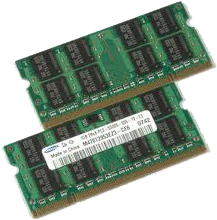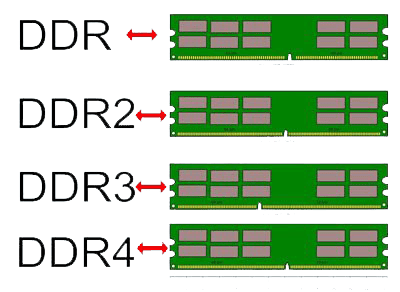Laptop & Desktop RAM Upgrade/Replace


There are many types of ram, some of which are no longer used or just never caught on as the standard because of the cost of manufacturing (ie rdram). Regular sdram modules are categorized as pc100 or pc133. DDR or double data rate ram, is more current and faster than sdram. The four types are DDR, DDR2,DDR3 & DDR4.The four types are notched differently to tell them apart, but they also vary in speed and density. Generally when looking to replace or upgrade ram, you will want to go for ram that is low in density (more IC chips), and you want to upgrade with matched pairs. You can generally go for the highest in frequency that that particular ddr ram supports as they are backwards compatible for slower speeds.
As mentioned, when a system has its ram resources completely used, the overall responsiveness of the computer will be slow. A temporary portion of the hard drive, a.k.a. the page file, is set aside for such a case. However the access times to and from the hard drive are a lot slower than that of ram, so even though it keeps things operative, it is still not the ideal solution. If you have ever seen a pop up by the system time on Windows machines that “Your system is low on virtual memory” that is the paging file at work. That could be a sign to look into upgrading your memory as constant reading from the page file is known as disk thrashing and in turn the system will become unresponsive or slow.
ComputeRx can help you when you need to replace or upgrade your ram. Software maintenance and virus protection & removal is equally as crucial for a fast/responsive system.Visit my software section to see how.
RAM (random access memory) of a computer serves as the temporary working and storage area for the processor, a.k.a. CPU, of a system. The operating system and any application communicate with the CPU to carry out its desired task. An application will place its relevant data in RAM so that the CPU has fast access to it. Once a system’s RAM is allocated to the operating system and other applications, subsequent RAM requests from the CPU for processes that need RAM, in effect, have to wait their turn for RAM to become available or will use the function of virtual memory, thus slowing the system down. Upgrading your system’s RAM is an easy way to increase a system’s performance.
A defective RAM module will usually render a system unusable. If one RAM module out of four is bad, you would want to replace it as the general rule of thumb is that you want to have like pairs of RAM modules.
Typical symptoms of defective RAM include:
- The system not booting (with possible beep codes)
- No Display, graphics glitches, Kernel panics
- System freezing, restart loops, system32 error messages
- Blue screen of death errors (B.S.O.D)

